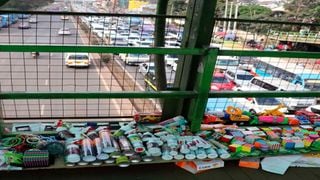
Hawkers selling their wares at the Ngara footbridge on Thika Road in Nairobi on Sunday, July 18, 2021, making it difficult for pedestrians to use it.
| Dennis Onsongo | Nation Media GroupNairobi
Premium
Revealed: ‘landlords’ who take rent from hawkers invading Nairobi footbridges
Have you ever wondered why all Nairobi footbridges with high human traffic have been invaded by hawkers who seem unusually comfortable?
Well, wonder no more. The hawkers are tenants just like those in shops or stalls in the city, months-long investigations by Nation.Africa have established.
Evening is fast approaching and the traffic out of Nairobi and onto Thika Road is building up.
And as if in rhythmic tandem with the vehicular and human traffic along the busy highway, the Ngara footbridge is teeming with people.
Among this sea of humanity, however, are a group of people who are in no rush to head home like the rest: the hawkers of Nairobi's footbridges.
For them, it is like the day has just begun. They have spread their merchandise, ranging from electronics and clothes to shoes and handbags, on one half of the footbridge, cashing in on the evening human snarl-up.
But this is not an isolated case. The hawkers have taken a stranglehold of almost all footbridges across the capital city. From Mbagathi and Kariobangi to Jogoo Road and Haile Selassie Avenue, footbridges have become their stomping ground.
They have managed to squeeze pedestrians to one side of the footbridges and turned them into their makeshift markets.
Footbridges on Outer Ring Road, Mbagathi Way and Thika Road have turned into hawkers’ dens.
However, these are not your usual hawkers who invade streets.
On footbridges, it is a case of landlords and tenants.
Here, you cannot just walk in and spread your wares. At the centre of the web are Nairobi County government inspectorate officers, disparagingly referred to as kanjos, and crooked high-ranking city police officers.
There are caretakers here too and they religiously report to the ‘landlords’: in this case, corrupt city inspectorate officers.
The rogue inspectorate officers run footbridges where they collect “rent” every week in exchange for the hawkers to freely operate in the spaces. The hawkers also have to pay something small to police officers to avoid constant harassment.
Our investigations started on Thika Road, with the Ngara footbridge as the first stop. It is noon and we find a few hawkers already in business.
One is unpacking men’s clothing at the foot of the footbridge on the side adjacent to the Ngara matatu stage and the small eateries therein. We ask if we can also get space to spread our wares.
The hawker says the spaces have their people but one can use such spaces before the “owners” come, after which the temporary occupier will have to relocate.
Hawkers selling their wares at Bellevue footbridge on Mombasa road in Nairobi on Sunday, July 18, 2021, making it difficult for movement.
He adds that the spaces at the top of footbridges and those next to bus stops or markets are more expensive because of their proximity to potential clients.
“I’m using this space because the owner has not arrived as it is still early in the day. When he comes in I will have to find another spot,” he says.
At the top of the footbridge and on one side of the straight aisle, the hawkers line up in perfect harmony that the great music assembler Ludwig van Beethoven would be proud of.
Here, it is not too chaotic. However, this is temporary as it is too early in the day. The place always becomes packed with the hawkers at peak hours.
Human traffic
“Business is booming on evenings when there is high human traffic as people are heading home from work. The place will soon be full as evening beckons,” avers another hawker.
At the other foot of the footbridge is another hawker. He is selling women’s handbags and foot mats made of blanket-like materials.
He explains that they are not supposed to operate on footbridges but depending on how one “talks” to the kanjos, city inspectorate officers, then an individual can be allowed to spread their wares.
The hawker, just like the others, says there are no spaces available as everyone is back after a short hiatus forced on them by the peak of the coronavirus.
“Kanjos do not want us here but it depends on how you talk to them. It is like how you woo a girl. She might agree to my advances but say no to you. So it depends and nothing is cast in stone,” he says. He is very guarded in what he discloses.
The hawkers do not just occupy any footbridge. The small-scale traders find the spaces the same way an individual finds a convenient house to rent. They do not just occupy any footbridge.
The hawkers have managed to squeeze pedestrians to one side of the footbridges and turned them into their makeshift markets.
In fact, footbridges near markets are considered prime sites and a spot check by the Nation established that they are fully occupied by the traders. They mostly occupy footbridges near markets.
On Thika Road, the footbridges in Pangani, Muthaiga Police Station/Mathari Hospital, National Youth Service and next to Safari Park Hotel do not have any hawkers.
But the one at Roysambu has been annexed by hawkers. The same story is evident on Outer Ring Road, where the busiest footbridge – at Mtindwa Market - has been overrun.
The same case applied to the Kariobangi North footbridge on Outer Ring Road and Muthurwa Market one. But why is this the case?
Two factors stand out: Most of the hawkers operate in the markets for the better part of the day and then rush to cash in on the evening human traffic on the footbridges.
Another reason is that there are hawkers who do not have space in the markets but are aware that such markets bring human traffic who are potential buyers.
“During the day a majority of us sell our wares in stalls in markets next to the footbridges. Then in the evening traffic, we come to the footbridges,” offered one hawker.
Already in business
When Nation.Africa visited the first footbridge on Outer Ring Road coming from Thika Road, a few hawkers were already in business.
At the next footbridge just before Kariobangi North Market hawkers were also already in business.
And there too the story of tenants emerged.
“The spaces here are all taken and paid for. It is very hard to get a space that does not belong to someone. You can only get space when the owner is not around,” said a woman hawker.
Citing frustration that we could not get space to display our wares and make some money in the middle of a global pandemic, we prodded her and she became empathetic.
She told us that we could register with Sh200 to join and the money will be taken by three of their leaders at the footbridge.
“When you join, you come with Sh200, where Sh100 will go to the police and the rest remains with us to register you as one of our own,” she avers.
The hawkers will write down their names and then deposit the list with a top police officer to spare them any harassment by police as they know they are not supposed to be operating on footbridges.
“We also each pay Sh50 every Wednesday to the kanjos. There are two women who usually come to collect the money every Wednesday afternoon.”
At the next footbridge, opposite the Kenya Muslim Academy, another hawker confirms the information, adding that the county askaris have a mobile money paybill number where the money is deposited.
“One has to make sure the money is in M-Pesa. They come every Wednesday. Like now they are about to come. The bribe sometimes depends on what one is selling,” he says.
On Thika Road, the footbridges in Pangani, Muthaiga Police Station/Mathari Hospital (pictured), National Youth Service and next to Safari Park Hotel.
He also said plainclothes police officers harass them when they do not give them “something small”.
“Like last week, we were chased around. So this week most people did not open. That is why you can see those empty spaces around. It is risky here but we have no choice. We have to fend for ourselves.”
At the footbridge opposite Pipeline Railway Station, next to Fedha Road, only a few hawkers were spotted.
The footbridge next to the road leading to Manyanja Road had none at that time.
Deserted
The spot check continued and the footbridge at the Landhies Retail Market was deserted as it is now a sleeping area for street urchins.
A similar pattern was witnessed on the footbridge connecting Muthurwa Market and Machakos County Bus and the one leading into Muthurwa Market, next to Wakulima Market, where only one side is used by hawkers.
Reached for comment, Nairobi Metropolitan Services (NMS) Security and Compliance Chief Officer Mark Leleruk acknowledged that there are some “bad apples” in the city inspectorate but they are working to weed them out.
NMS transferred at least 14 senior inspectorate officers this month, he said, as the first step in restoring order in the department perennially plagued by corruption accusations.
“Some of the officers have been behind what ails the capital city in terms of hawkers, parking boys, crooks in city toilets, boda bodas in the city centre and illegal clamping and towing of vehicles working together with private breakdown service providers,” Dr Leleruk said.
“Nairobi residents have suffered at the hands of some uniformed inspectorate officers and this has to come to an end.”
For his part, Nairobi police boss Augustine Nthumbi dismissed the claims that some senior police officers are being paid to protect hawkers, saying police are not involved in issues involving hawkers as that is under the jurisdiction of NMS.
Police only come in when NMS requests security during their operations, he said.
“So when someone tells you that the police are being paid to protect hawkers, it is a total lie. They only want to smear the police because that is sweet music to people’s ears,” he said.
“Why do people have to go for police necks anytime they feel like? Let them talk about NMS because it is the agency managing the city.”
When the Kenya National Highways Authority (Kenha) built the footbridges, they were meant to help reduce pedestrian deaths by ensuring their safety when they cross busy roads in the capital city. They were also meant to ensure a smooth flow of vehicles on highways. But many have found new uses.
The agency’s mandate, said Kenha communication manager Charles Njogu, starts and ends with construction and structural maintenance of the facilities.
Proliferation of hawkers
Operational responsibility involving these structures lies with the respective county governments where they are situated, he said.
“You may therefore need to get in touch with the county government of Nairobi regarding this situation of hawkers,” he said.
Besides the profiteering officials, politicians have also been blamed for fuelling the proliferation of hawkers on footbridges, with MCAs and even MPs making requests to the county government to allow “their voters” to sell at the footbridges without being harassed.
Last month, NMS boss Maj-Gen Mohamed Badi alluded to those claims, saying the matter of hawkers in Nairobi is a political issue as they are brought in by local politicians.
He said city officials have always faced resistance from politicians when they try to remove hawkers as they are taken to court by the politicians, who then get court injunctions to stop such operations.
“This is a political issue where we have a lot of interested people. They bring them from the estates because these are people who vote for them, are their campaigners and so it has been a big hassle to get rid of them as every time we remove them they bring them back,” Maj-Gen Badi lamented.
“We are trying to negotiate with the county assembly where the politicians are so that we carry out a joint operation to remove the hawkers,” he added.
The hawkers have taken a stranglehold of almost all footbridges across the capital city. From Mbagathi and Kariobangi to Jogoo Road and Haile Selassie Avenue, footbridges have become their stomping ground.
For instance, in February 2020, at least 320 hawkers were arrested as police intensified their operation to decongest footbridges in Nairobi following a directive by Deputy Inspector-General of Police Edward Mbugua.
True to Mr Badi’s concern, the Nairobi regional police boss at the time, Philip Ndolo, said a politician made phone calls to various senior police officers, including himself, over the arrests.
He wanted the hawkers to be released unconditionally. He said the politician’s demands were turned down.
The hawkers were arraigned and fined between Sh2,500 and Sh5,000. But most of these fines are paid by the politicians.





